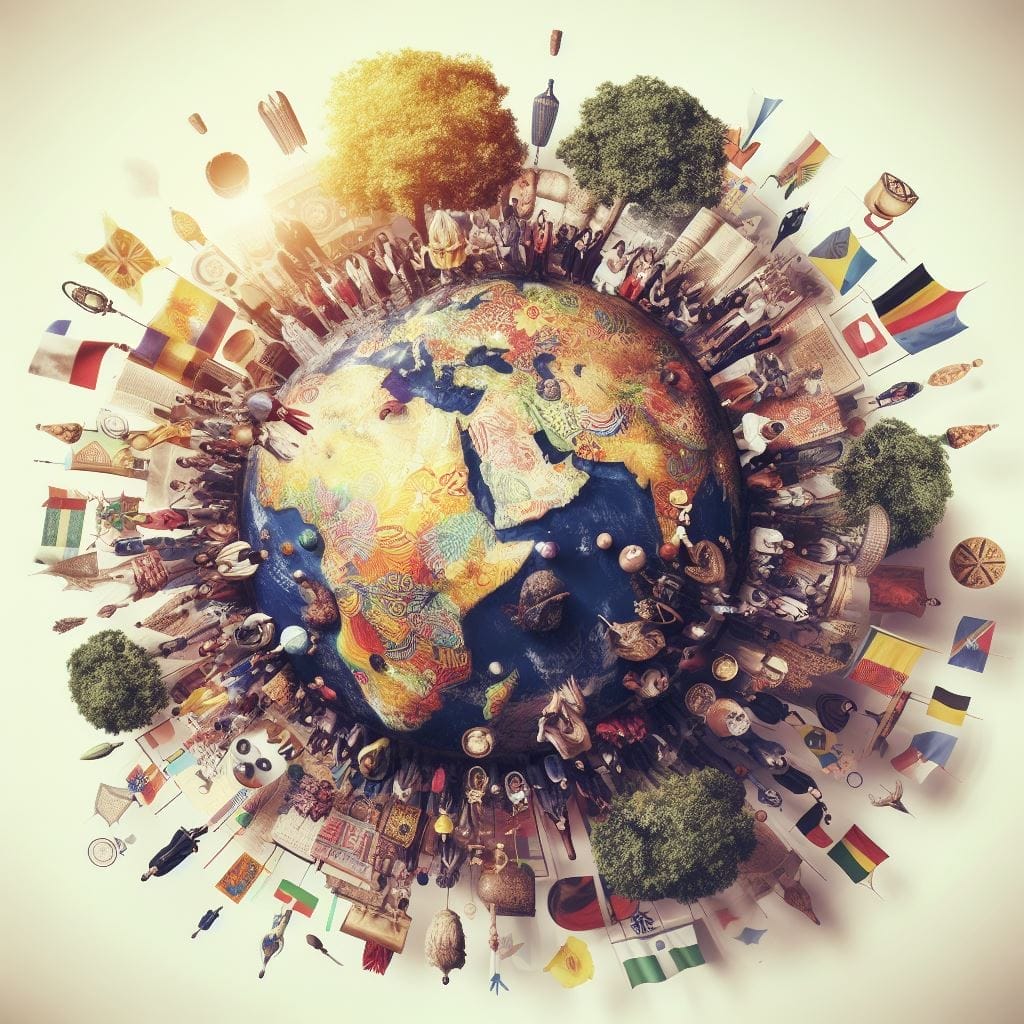Introduction
In a world that celebrates variety, navigating the terrain of various cultures has come to be important to each of our non-public and expert lives. As we assignment into the dynamic realm of labor, the significance of cultural sensitivity turns into obvious—no, imperative. Ask yourself today: How can I improve my cultural awareness?
Understanding and appreciating cultural variations, fostering a culturally conscious environment, and striving for cultural competence are not simply buzzwords; they may be the cornerstones of effective conversation, expanded productiveness, and inclusive attitudes.
In this exploration of cultural recognition in the place of business, we delve into the depths of the way a multicultural perspective can not simplest apprehend our colleagues’ various backgrounds but also destroy limitations that may avert productiveness.
Join us on this journey of discovery as we unravel the layers of go-cultural interactions, emphasizing the price of being culturally aware to create inclusive and harmonious work surroundings.
Key Takeaways
- Elevated Cultural Awareness: By giving up this blog, readers can have profound know-how of the importance of cultural consciousness in the place of a job. They’ll be prepared with insights into how embracing various backgrounds contributes to a greater inclusive and harmonious professional environment.
- Practical Steps for Improvement: Our exploration offers actionable steps to boost cultural cognizance. Readers will discover strategies to mirror their cultural biases, train themselves about special cultures, interact in cultural activities, and interact with people from diverse backgrounds.
- Benefits Beyond Boundaries: Unlock the blessings of stepped-forward cultural recognition, which include more advantageous communique skills, extended empathy, and a higher capability to adapt to various settings. These abilities no longer best foster enriched place of work relationships but additionally create networking opportunities that transcend cultural limitations.
- Navigating Challenges with Grace: Readers will advantage of insights into overcoming challenges related to cultural variations, which include language limitations, and stereotypes, and navigating cultural taboos. This blog gives a manual on drawing near these boundaries with sensitivity and open-mindedness.
- A Call to Action for Inclusivity: The weblog concludes with an effective encouragement for readers to actively incorporate cultural consciousness into their everyday expert lives. It emphasizes that embracing cultural range isn’t most effective a duty however a method for fostering a more inclusive and efficient administrative center.
Embark on this insightful journey, and find out how cultivating cultural consciousness can enrich your professional existence and make contributions to a more connected and understanding worldwide network.

Understanding the Concept of Cultural Awareness
In nowadays’s globalized global, wherein cultural variety is more common than ever, spotting and respecting numerous cultures isn’t always only a nicety but a need. Businesses and people alike should embody variations as possibilities for the boom. Developing empathy towards different cultures isn’t just a buzzword but an ability that may extensively impact relationships and productivity.
Cultural Sensitivity and Beyond
Embracing Different Cultural Norms
To build cultural focus, one needs to first understand the myriad approaches people from different backgrounds specific to themselves. From body language to communique competencies, every culture has its particular set of norms. Being culturally touchy entails no longer just know-how but appreciating these variations.
Overcoming Cultural Barriers in Organizations
In the search for a culture in a position workplace, it’s important to perceive and triumph over cultural boundaries. Misunderstandings can stand up, however with formal training and a mindful technique, businesses can promote inclusivity and raise their work environments.
The Role of Cultural Intelligence
Navigating Intercultural Communication
Cultural intelligence performs a pivotal function in navigating the complexities of intercultural communication. Whether it’s a multicultural team or dealing with traders from distinctive ethnic businesses, expertise in the variations beyond subculture is key.
Creating More Robust Relationships
Increasing your cultural awareness doesn’t just stop at avoiding misunderstandings; it leads to stronger relationships. Employees who learn about different cultural identities and are mindful of non-verbal cues can communicate effectively, fostering a sense of inclusivity.
Diversity and Inclusion: A Business Imperative
Business Etiquette in a Multicultural World
In the U.S. And past, wherein groups often have interacted with humans from various backgrounds, understanding the business etiquette that transcends cultural limitations is essential. From non secular holidays to formal methods of communication, being culturally sensitive is not only a preference but a necessity.
Fostering Diversity in the Workplace
To cause greater range and inclusion, groups must first apprehend the nuances of various corporations. This goes past race and ethnicity, encompassing various cultural impacts that form an individual’s views and moves.
The Impact on Communication Skills
Beyond Culture: Cross-Cultural Communication
It’s vital to recognize that past cultural conversation goes past acknowledging cultural differences. It includes formal education, and an openness to study one-of-a-kind cultures inside and beyond your organisation.
Diverse Perspectives in Social Interactions
In social interactions, whether it’s in the place of business or regular existence, being aware of the cultural nuances can cause more inclusive and significant conversations. Religious establishments, for instance, frequently offer a rich tapestry of cultural practices that, whilst understood, can foster more potent connections.
Steps to Improve Cultural Awareness
Cultural diversity is a wealthy tapestry that provides vibrancy to our worldwide network. Understanding and appreciating exclusive cultural backgrounds no longer simplest enriches our private lives but is likewise crucial in fostering effective relationships in places of work and groups.
In this segment, we can explore realistic steps to enhance cultural recognition, fostering surroundings of inclusivity and information.
I. Reflect on Your Cultural Background
A. Understanding Your Own Biases and Stereotypes
Reflecting on oneself is step one in the direction of taking a ride toward cultural consciousness. Think again for a moment, recognizing and comprehending any prejudices or preconceptions you may have. This self-consciousness is the inspiration for embracing variety.
B. Recognizing How Your Cultural Background Shapes Your Perspective
Our cultural upbringing has a profound influence on our worldview. Recognize the impact of your cultural background on your attitude. How does it impact your attitudes, conduct, and interpersonal relationships?

II. Study Up on Various Cultures
A. Reading Literature on Other Cultures in Books, Articles, or Blogs
Expand your horizons by immersing yourself in literature that delves into numerous cultures. Reading books, articles, or blogs gives insights into distinct customs, traditions, and ways of questioning.
B. Seeing films or documentaries that highlight various cultures
Visual storytelling is an effective way to learn about distinct cultures. Watch documentaries and films highlighting the world’s civilizations’ diversity and richness.
III. Engage in Cultural Activities and Experiences
A. Partaking in Cultural Festivals, Events, or Celebrations
Participate actively in cultural galas and occasions. Immerse yourself in the festivities, and know the significance of rituals and traditions. It’s a wonderful manner to realize variety firsthand.
B. Trying Out Traditional Cuisines From Various Cultures
Food is a familiar language that cuts across cultural barriers. Explore numerous cuisines, tasting the flavors of many cultures. This not handiest pleases the palate but also fosters a reference to cultural practices.
IV. Interact With People From Different Cultures
A. Joining Multicultural Clubs or Organizations
Actively are seeking out multicultural clubs or businesses for your network or administrative center. Engaging with these organizations offers opportunities for significant connections and deeper information on cultural nuances.
B. Holding Discussions With People From Various Backgrounds
Strike up conversations with people from various backgrounds. Listen actively, ask questions, and share your reviews. Building personal connections breaks down barriers and promotes cultural sensitivity.
V. Travel and Explore Different Countries
A. Experiencing Firsthand Cultural Practices and Customs
Immersion in many cultures can be achieved through travel in a distinctive manner. Learn about the customs, habits, and behaviors of the places you visit firsthand. It broadens your perspective and deepens cultural awareness.
B. Learning About Local Traditions and History
Delve into the history and traditions of the places you explore. Understanding the context of cultural practices enhances your appreciation and fosters a respectful attitude toward diversity.
Cultural knowledge will benefit not only personal development but also the formation of strong ties with people from other cultures. It is essential in increasing competency in a range of settings, including educational institutions, corporations, and community organizations.
A Roadmap to Cultural Fluency: Twelve Steps to Enhance Cultural Awareness
| Embarking on the Journey to Cultural Awareness | Navigating the Pathways of Understanding |
|---|---|
| 1. Reflect on Your Roots | Begin your cultural exploration by delving into the intricacies of your background. Understand your beliefs and biases as a stepping stone closer to embracing range. |
| 2. Dive into Cultural Narratives | Immerse yourself in the rich tapestry of global cultures. Let books, cultural events, and diverse media be your guides in unraveling the fascinating stories and histories that shape our world. |
| 3. Mastering Cross-Cultural Conversations | Elevate your communication skills across cultural boundaries. Pay interest to non-verbal cues, adapt your communication fashion, and grasp the nuances of language to foster meaningful connections. |
| 4. Join the Mosaic of Communities | Break down barriers by engaging with people from various backgrounds. Attend cultural gala’s, be an active player in community activities, and include activities that encourage the beautiful alternate of numerous perspectives. |
| 5. The Art of Cultural Sensitivity | Consider enrolling in cultural sensitivity workshops. These sessions offer practical insights, equipping you with the tools to navigate diverse environments with grace and understanding. |
| 6. Cultivate Inclusive Spaces | Nurture environments where everyone feels valued and included. Foster open conversations that remember the richness of range, whether for your neighborhood community or administrative center. |
| 7. Embark on a Cultural Odyssey | Expand your horizons through travel. Visiting special regions and nations exposes you to a myriad of cultures, allowing you to soak up local customs and traditions firsthand. |
| 8. Staying In Tune with Global Dynamics | Stay informed about global affairs. A wide know-how of international events enhances your appreciation for the cultural impacts shaping societies around the world. |
| 9. Shattering Stereotypes | Challenge and shatter stereotypes consciously. Acknowledge the variety within cultures, recognizing that generalizations can perpetuate misunderstandings and restrict real connections. |
| 10. Language as a Gateway | Take on the challenge of learning a new language. Beyond linguistic talent, it offers profound insights into a tradition’s nuances, demonstrating your dedication to cross-cultural know-how. |
| 11. Embrace the Humility of Cultural Learning | Approach cultural awareness with humility. Acknowledge that your understanding can be confined, and continue to be open to persistent getting to know others’ stories and views. |
| 12. Seek Illumination through Feedback | Actively seek feedback from individuals of different cultural backgrounds. Embrace their insights into your movements and conversation, using them as a compass for the ongoing refinement of your cultural recognition adventure. |
Embark on this journey with an open coronary heart and mind, embracing the diverse threads that weave the tapestry of our global network.

Benefits of Improving Cultural Awareness
A. Enhanced Communication Skills
Cultivating cultural cognizance for your administrative center goes beyond merely acknowledging variety; it’s about developing a keen sensitivity to the intricacies of conversation patterns. This heightened recognition opens up channels for more effective and nuanced communique, transcending language obstacles. It’s not just about what’s said, but additionally about how it is stated, considering the numerous approaches unique cultural businesses express themselves.
B. Increased Empathy and Understanding Towards Others
In the elaborate tapestry of organizational dynamics, empathy is the thread that weaves robust connections. Gaining cultural awareness encourages an extra comprehension of the various viewpoints that people with diverse cultural origins convey to the desk. This promotes a more welcoming and nonviolent place on the job further encouraging empathy.
C. Improved Ability to Adapt in Diverse Environments
Organizations these days operate on a worldwide scale, and flexibility is a prized ability. Understanding cultural nuances provides a roadmap for navigating the complexities of diverse environments. It’s approximately being attuned to the unspoken norms and customs that shape the professional landscape, allowing for a continuing integration into unique organizational contexts.
D. Strengthened Relationships and Networking Opportunities
In the area of expert increase, relationships are frequently the cornerstone. Developing cultural attention no longer best enables smoother interactions within your immediate group but additionally opens doorways to broader networking opportunities. Understanding the cultural intricacies of different groups fosters a sense of trust, laying the foundation for meaningful and lasting professional relationships.
Also Important: Ways to Think Beyond the Surface
To truly develop cultural awareness, it’s imperative to go beyond surface-level acknowledgment. It involves a continuous effort to understand cultural groups within your organizational sphere, including often overlooked aspects of behavior. This depth of understanding creates a more meaningful and authentic cultural awareness.
Understanding Cultural Diversity in Organizational Context
To increase cultural consciousness in your administrative center, it’s important to apprehend the particular dynamics of your organizational culture. This consists of acknowledging the effects of Hispanic cultures, nonsecular establishments, and different diverse factors that contribute to the wealthy tapestry of your place of work.
Overcoming Obstacles to Increasing Cultural Sensitivity
A. Overcoming Language Barriers
One of the number one hurdles in reaching cultural focus is the presence of language boundaries. As groups expand globally, their staff becomes increasingly varied, bringing together people with various linguistic backgrounds. To grow to be aware of this mission, personnel may additionally locate the following techniques worthwhile:
- Language Immersion Programs: Encourage staff members to participate fully in language-learning initiatives. This improves communication and promotes a greater comprehension of various cultural perspectives.
- Multilingual Resources: Provide resources in multiple languages. This can vary from official documents and schooling materials to everyday communications. It guarantees that language doesn’t act as a barrier to comprehension.
- Cross-Cultural Communication Workshops: Conduct workshops that concentrate on powerful go-cultural verbal exchange. This goes past language proficiency and encompasses expertise nuances, tone, and non-verbal cues.
B. Addressing Cultural Stereotypes and Biases
Cultural stereotypes and biases can preclude actual knowledge and collaboration. To overcome these, personnel may additionally undertake the following processes:
- Cultural Sensitivity Training: Implement training programs that sensitize personnel to cultural differences. This is not the most effective demanding situation current stereotypes however also promote a greater inclusive attitude.
- Diverse Leadership Representation: Foster diversity at management stages. Having leaders from various cultural backgrounds sets an instance and dismantles preconceived notions about competence-based totally on cultural starting place.
- Promoting Open Dialogue: Create a tradition of open dialogue where employees feel cushty discussing cultural variations. This facilitates spoiling down stereotypes and fosters a feeling of shared expertise.
C. Understanding and Navigating Cultural Taboos
Navigating cultural taboos requires delicate stability. It involves being privy to cultural norms and adapting behaviors accordingly. Employees can navigate this terrain by using:
- Cultural Sensitivity Training (Again!): Yes, it’s crucial, and it applies here too. Understanding cultural taboos is a considerable component of cultural sensitivity training.
- Cultural Liaisons or Mentors: Establish mentorship programs where employees can seek guidance from colleagues familiar with the intricacies of different cultures. This can prevent unintentional breaches of cultural taboos.
- Regular Cultural Updates: Cultures evolve, and what might be taboo today may not be tomorrow. Providing regular updates on cultural norms ensures that employees stay informed and adaptable.

Developing Cultural Intelligence: Methods to Address Major Obstacles
| Navigating Challenges in Cultivating Cultural Awareness | Effective Strategies for Overcoming Hurdles |
|---|---|
| 1. Limited Exposure to Diversity | Encourage Immersive Cultural Experiences: Foster engagement in diverse cultural events, festivals, and community activities to broaden perspectives. |
| 2. Battling Stereotypes and Biases | Igniting Awareness Through Education: Conduct workshops and awareness campaigns to challenge stereotypes, fostering a deeper understanding of cultural nuances. |
| 3. Overcoming Communication Barriers | Empowering Cross-Cultural Communication: Provide language training to enhance communication skills, facilitating meaningful exchanges between individuals from varied backgrounds. |
| 4. Addressing Fear of Unintentional Offense | Cultural Sensitivity Training: Implement training sessions to navigate cultural sensitivities, addressing concerns about unintentional misunderstandings or offenses. |
| 5. Promoting Inclusive Environments | Championing Inclusivity: Advocate for inclusive policies within organizations to ensure that individuals from all cultural backgrounds feel valued and included. |
| 6. Combating Cultural Ignorance | Embedding Cultural Education: Integrate cultural education seamlessly into educational curricula and workplace training programs to enhance awareness and knowledge. |
| 7. Overcoming Resistance to Cultural Shifts | Leadership Advocacy: Garner support from organizational leaders to champion cultural awareness initiatives, fostering a culture of openness and adaptability. |
| 8. Tackling Unconscious Bias | Unveiling Implicit Biases: Roll out training programs that delve into unconscious biases, empowering individuals to recognize and overcome these biases in their thoughts and actions. |
| 9. Striving for Diversity in Leadership | Fostering Leadership Diversity: Promote diversity in leadership roles, showcasing the significance of varied perspectives and experiences at all organizational levels. |
| 10. Bridging Cultural Competency Gaps | Continuous Learning Culture: Cultivate an environment of ongoing learning, motivating individuals to actively seek knowledge about different cultures and enhance their cultural competence. |
| 11. Addressing Resource Constraints | Strategic Resource Allocation: Ensure that ample resources—be it time, budget, or personnel—are dedicated to cultural awareness programs and initiatives. |
| 12. Mitigating Fear of Cultural Appropriation | Establishing Clear Guidelines: Develop transparent guidelines and policies on cultural appropriation, providing a framework for respectful cultural interactions. |
My Journey in Cultivating Cultural Awareness
In my existence, pursuing the direction of cultural awareness has been a life-converting and enriching revel in. The starting of all of it becomes a profound realization: the globe is a mosaic of numerous cultures, every adding its distinct colors to the human canvas. Reflecting on my cultural history became the cornerstone of this enlightening adventure.
In acknowledging my biases and stereotypes, I exposed the subtle methods wherein my cultural upbringing shaped my perspectives. This self-focus laid the foundation for embracing the concept of cultural consciousness no longer as a theoretical notion but as a lived enjoyment.
Education emerged as a powerful ally. Diving into books, articles, and documentaries approximately one-of-a-kind cultures broadened my horizons and cultivated empathy. It wasn’t simply about understanding differences; it changed into approximately appreciating the memories, traditions, and values that made each subculture wonderful.
Interacting with individuals from diverse backgrounds has become a pivotal chapter. Joining multicultural golf equipment and being attractive in conversations allowed me to witness the richness of cultural nuances firsthand. It changed via these interactions that stereotypes have been dismantled, making room for genuine connections.
Travel, certainly, became a highlight. Experiencing distinctive international locations intended to immerse myself in neighborhood customs, traditions, and histories. It wasn’t just about sightseeing; it turned into about soaking up the essence of cultures, from savoring conventional cuisines to participating in nearby festivities.
The blessings of this cultural focus journey manifested in numerous factors of my existence. Communication developed right into a talent for bridging gaps, fostering expertise even amid range. Increased empathy has become a guiding principle, fostering meaningful connections with humans from all walks of life.
Overcoming challenges, including language limitations and addressing stereotypes, have become increased opportunities. The commitment to navigating cultural taboos transformed into a commitment to promoting respectful and inclusive dialogue.
As I stand today, strengthened relationships and expanded networking opportunities testify to the profound impact of cultivating cultural awareness. The journey has not only enriched my personal life but has equipped me to contribute positively to a globalized society.
In closing, my experience underscores the transformative power of cultural awareness. It’s no longer simply a tick list of steps but a continuous exploration, a mindset that enriches each interplay and relationship. I encourage anybody to embark on this journey, for in understanding and celebrating our variations, we pave the way for a greater harmonious and interconnected global.

FAQs:
How can individuals actively develop cultural competence to navigate and appreciate the nuances of cultural differences in today’s diverse society?
People can contribute towards awareness promotion by undertaking varied cultural activities like attending cross-cultural parties or participating in informative discussions. The need for developing cultural competence as part of the strategies of coping with complexity and diversity existing in the contemporary pluralistic society cannot be overemphasized. This includes now not simply acknowledging diverse perspectives but also understanding and appreciating the nuances that form them.
What practical steps can one take to turn out to be greater culturally conscious and sensitive, fostering a nice mindset closer to embracing cultural impacts in both verbal and non-verbal verbal exchange?
Taking sensible steps to decorate cultural recognition will help individuals foster effective attitudes toward their relationships with humans from special backgrounds. Actively seeking to understand different cultural influences, both in verbal and non-verbal communication, becomes a meaningful way to share and connect with others. By doing so, one contributes to a more inclusive and harmonious societal fabric.
In what ways does cultivating a culturally aware attitude contribute to bridging gaps and fostering understanding amidst cultural differences, promoting effective development of cultural awareness?
Cultivating a culturally aware attitude plays an important role in bridging gaps and fostering understanding among individuals with diverse backgrounds. This methodology not only fosters consciousness and comprehension but also fortifies bonds with individuals from diverse cultural backgrounds. As a result, it develops into a potent tool for exchanging stories and fostering unity despite cultural differences.
How can people proactively decorate their cultural attention using incorporating non-verbal cues and gestures, ensuring a greater culturally sensitive method in their interactions?
By the use of non-verbal clues and gestures in their interactions, humans can actively enhance their cultural recognition. This ensures a more culturally sensitive approach, facilitating effective communication. Recognizing the significance of non-verbal elements contributes to the overall development of cultural awareness, allowing individuals to navigate diverse social contexts with greater ease.
What role does intentional effort play in the continuous journey to develop cultural awareness, and how can individuals maintain a balance between cultural influences and their own culturally sensitive attitudes?
Intentional effort plays a crucial function in the non-stop adventure to broaden the cultural focus. To preserve stability between cultural effects and one’s very own culturally touchy attitudes, people must actively are seeking for possibilities to recognize special views. This ongoing commitment to growing cognizance will become a dynamic manner to share reports, fostering mutual knowledge and appreciation in a multicultural society.
Conclusion: How Can I Improve My Cultural Awareness
In the end, developing cultural consciousness isn’t always simply an academic pursuit; it’s an adventure of personal increase and global information. As we replicate the important thing factors discussed during this exploration of cultural awareness, we discover that:
- Cultural recognition is an ongoing manner: It involves recognizing, respecting, and embracing the richness of numerous cultures, making it a fundamental part of our private and societal development.
- Personal reflection is the first step: Acknowledging our own biases and know-how of the effect of our cultural and historical past on our perspectives lays the inspiration for true cultural recognition.
- Education is an effective device: By immersing ourselves in literature, media, and direct reports from one-of-a-kind cultures, we increase our expertise and domesticate empathy.
- Interacting with humans from diverse backgrounds is critical: Meaningful engagement fosters a deeper knowledge of cultural nuances and facilitates wreck down stereotypes.
- Travel is a transformative experience: Exploring different nations gives firsthand publicity to precise traditions, fostering a profound appreciation for the worldwide range.
Call to Action:
Embrace the beauty of our international tapestry and rejoice in the specific contributions each thread brings. By doing so, we no longer only enhance our lives but make contributions to the advent of a more harmonious and interconnected international. Start your cultural recognition adventure nowadays; the sector is ready to be observed.

Sarah Andrews’ work on relationships is informed by a breadth of experience and a strong interest in human nature. Sarah, who holds a Psychology degree and has a good eye for nuances, delves into the complexity of communication and emotion, delivering insightful insights for readers seeking personal growth and emotional pleasure. Sarah hopes that her empathic approach and insightful suggestions will motivate readers to understand themselves and their relationships better.
